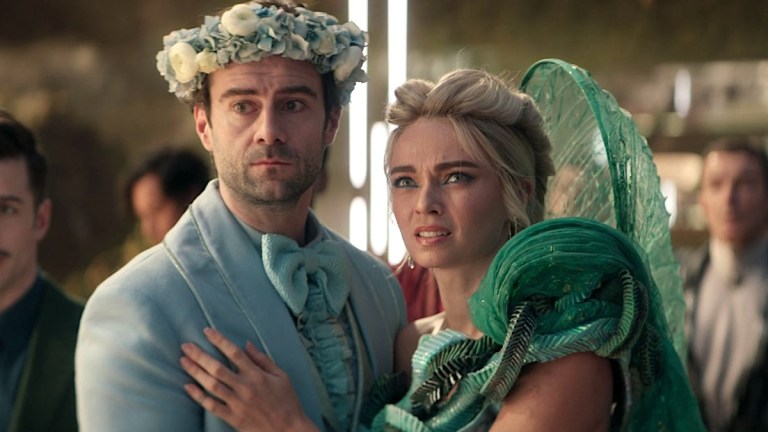Star Trek: Strange New Worlds Showrunners Explain a Unique Approach to Canon
Exclusive: The popular Star Trek spinoff is still a prequel to The Original Series, but the creative team admits they’ve taken some big swings.

As Star Trek: Strange New Worlds warps into its third season, longtime Star Trek fans have cause to celebrate. It’s actually been two years since Strange New Worlds debuted new episodes, and so the release of a new season will be like much-needed food for starving Trekkies. But those same fans almost certainly have questions. As the constellation of various relationships continues to become more complex in Strange New Worlds, fans might wonder how to reconcile what we’ve assumed about characters from The Original Series and what we’re now confronted with in Strange New Worlds.
Case in point, the second, just-debuted new episode, “Wedding Bell Blues” introduces us to the SNW version of Roger Korby, originally played by Michael Strong in 1966, but now played by Cillian O’Sullivan. And this new version of Korby is much more likable and dynamic than the original version. So has canon been changed or is there deeper Trek magic at work here?
“We’ll see whether we succeed or fail, but we still try to exist within the parameters of what might have been true in canon,” co-showrunner Akiva Goldsman tells us. “Now sometimes I think it’s challenging, especially with Korby because we’ve cast him as handsome and dashing and when we meet him later, he’s less handsome and dashing. But we cast him as someone who likes a flesh-and-blood person as their partner versus someone who might like a robot.”
Goldsman is referencing Korby’s eventual fate in the 1966 episode “What Are Little Girls Made Of?” in which Chapel’s former fiancé has surrounded himself with nothing but robots, and in fact, created a robot body for himself. In the grand scheme of The Original Series, the idea that Nurse Chapel had a failed and mysterious engagement is something that most fans viewed as a footnote, but in exploring all the years leading up to TOS in great detail, Strange New World is bound to bump up against some continuity problems. Logistically this makes SNW a bit like the Andor of the Star Trek franchise, albeit tonally and aesthetically still fairly lighthearted and colorful.
Because Strange New Worlds is giving us three more seasons of classic Trek-style adventures before Season 5 shows us the transition to The Original Series, there’s a slew of opportunities for new standalone sci-fi adventures but also even deeper dives into its characters, some of which have existed for nearly six decades.
“Representation of character is not character,” Goldsman says. “So these are representations of the Ur-Uhura and the Ur-Korby. That’s my story, and I’m sticking to it.”
In a way, Strange New Worlds has done more than simply recast characters like Spock, Pike, Uhura, Chapel, and most recently, Scotty. It’s created a different narrative context for the characters to exist. Both SNW and TOS are adventure-of-the-week TV series. But SNW has serialized character arcs that define the show, which is very different from TOS. And this seemingly minor alteration in storytelling style means that the representations of the characters sometimes feel different, even if the core characters still exist somewhere out there.
For what it’s worth, Goldsman’s assertion that a sort of Platonic ideal of the TOS crew exists beyond what we see on the screen has a precedent from Gene Roddenberry himself. In a preface to the novelization of Star Trek: The Motion Picture, Admiral Kirk tells the reader that certain dramatizations of his five-year-mission have led to misconceptions about what the crew was really like. Not only does this suggest that Star Trek exists within Star Trek (an idea SNW plays with later this season), it also suggests that Goldsman’s thesis was shared by the creator of Star Trek; seemingly conflicting interpretations of different characters can all be correct.
In short, SNW isn’t too worried about contradicting canon because, relative to narrative points of view, the Star Trek franchise already has a fix for that.
“You get away with more than you think,” Goldsman says. “And as we continue to relieve ourselves of the obligation of servicing everybody all the time, it lets us go deeper with the characters. This season we’re probably a little cockier with character moves than ever before.”
Star Trek: Strange New Worlds streams on Paramount+.
